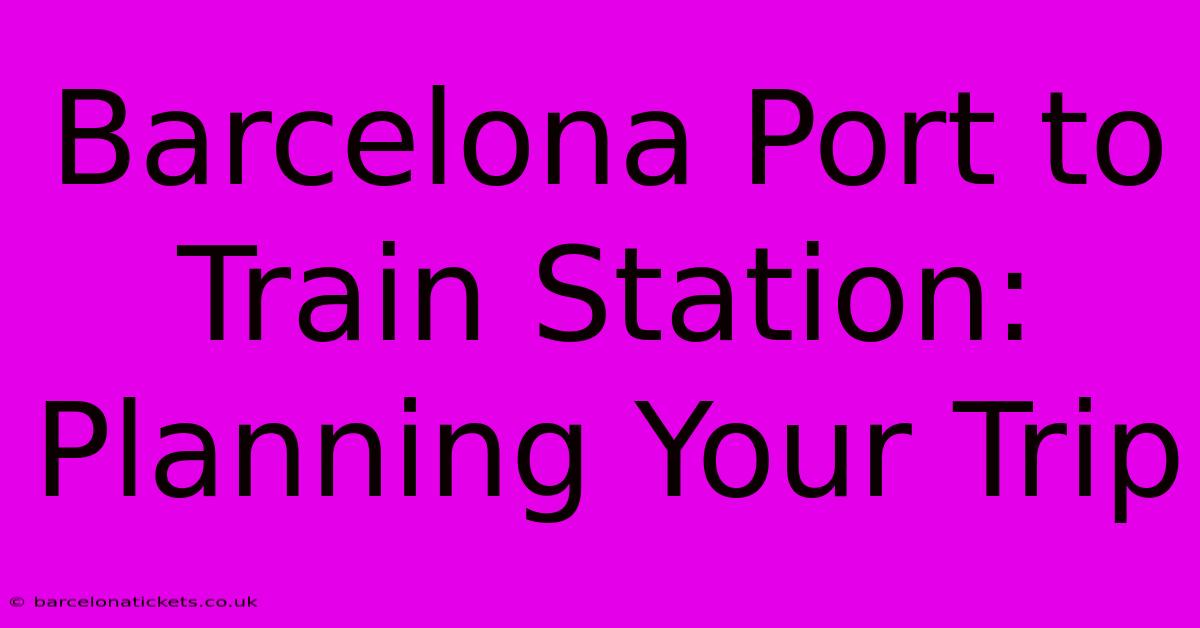Barcelona Port To Train Station: Planning Your Trip

Table of Contents
Barcelona Port to Train Station: Planning Your Trip
Planning a trip to Barcelona? Knowing how to get from the Port of Barcelona to the city's train stations is crucial for a smooth start to your adventure. This comprehensive guide outlines your options, helping you choose the best route based on your budget, time constraints, and luggage.
Understanding Your Starting Point & Destination
Barcelona's Port is a sprawling area. Knowing your exact location within the port – whether it's a cruise terminal, a ferry dock, or a specific area along the waterfront – will help you determine the most convenient transportation method. Similarly, Barcelona boasts several train stations, each serving different lines and destinations. Identifying your specific train station (e.g., Barcelona Sants, Passeig de Gràcia, França) is equally important for accurate travel planning.
Key Train Stations in Barcelona:
- Barcelona Sants: The city's main train station, connecting to high-speed AVE trains and regional services. It's usually the best option for long-distance travel.
- Passeig de Gràcia: A beautiful station serving regional and suburban lines, conveniently located near the city center and famous Gaudi architecture.
- Barcelona França: Primarily serving regional and commuter trains, particularly useful if your final destination is in the south of the city.
Getting from Barcelona Port to the Train Station: Your Options
You have several options for traveling from the Port of Barcelona to your chosen train station:
1. Taxi or Ride-Sharing Services (Uber/Cabify):
- Pros: Convenient, door-to-door service, especially useful with heavy luggage. Relatively quick, particularly during off-peak hours.
- Cons: Can be expensive, especially during peak times or with a larger group. Subject to traffic delays.
- Cost: Expect to pay between €20-€35 depending on the distance and traffic.
- Travel Time: Approximately 15-30 minutes, depending on traffic and your destination station.
2. Public Transportation (Bus & Metro):
- Pros: Affordable, readily available, and a great way to experience local transportation.
- Cons: Requires navigating the public transport system, which might be challenging for first-time visitors. Can be crowded during peak hours. May involve multiple transfers.
- Cost: Around €3-€5 per person.
- Travel Time: 30-45 minutes, or longer depending on connections and waiting time.
Specific Bus & Metro Routes: You'll need to consult a journey planner app (like Citymapper or Moovit) for the most up-to-date information on bus and metro routes, depending on your exact starting point within the port and your final train station. These apps account for real-time disruptions.
3. Aerobus (Airport Bus):
- Pros: A relatively inexpensive option if your route involves a connection near the airport.
- Cons: Only useful if your route happens to align with the Aerobus route. It will likely require additional transfers.
- Cost: Around €6-€7
- Travel Time: Varies greatly, but can be efficient if your route aligns with its path.
4. Walking (For Nearby Stations):
- Pros: Free, healthy, and a great way to see the city.
- Cons: Only feasible if your train station is within walking distance. Not recommended with heavy luggage.
- Cost: €0
- Travel Time: Varies greatly, but could take 30 minutes to an hour or more.
Tips for a Smooth Journey:
- Check Schedules: Before your trip, research train and bus schedules to avoid unnecessary waiting time.
- Purchase Tickets in Advance: For trains, consider purchasing tickets online to save time and potentially secure better prices.
- Allow Extra Time: Unexpected delays can occur. Build in extra time, particularly if using public transportation.
- Use Journey Planner Apps: Apps like Google Maps, Citymapper, and Moovit are invaluable for navigating Barcelona's public transport system.
- Pack Light: If possible, pack lightly to make your journey more comfortable, especially if you're relying on public transport.
By carefully considering your options and following these tips, you can easily and efficiently travel from Barcelona's Port to its train stations, ensuring a stress-free start to your Barcelona adventure. Remember to always check for any real-time updates or changes to schedules before you travel!

Thank you for visiting our website wich cover about Barcelona Port To Train Station: Planning Your Trip. We hope the information provided has been useful to you. Feel free to contact us if you have any questions or need further assistance. See you next time and dont miss to bookmark.
Featured Posts
-
Barcelonas Best Location Hotel Omm
Mar 29, 2025
-
Accura Bruc Your Luxurious Barcelona Retreat
Mar 29, 2025
-
Barcelona Onesie The Perfect Holiday Gift
Mar 29, 2025
-
Stunning Barcelona Apartments Unbeatable Cheap Prices
Mar 29, 2025
-
Spectacular Atmosphere Especiarium Bar Barcelona
Mar 29, 2025
